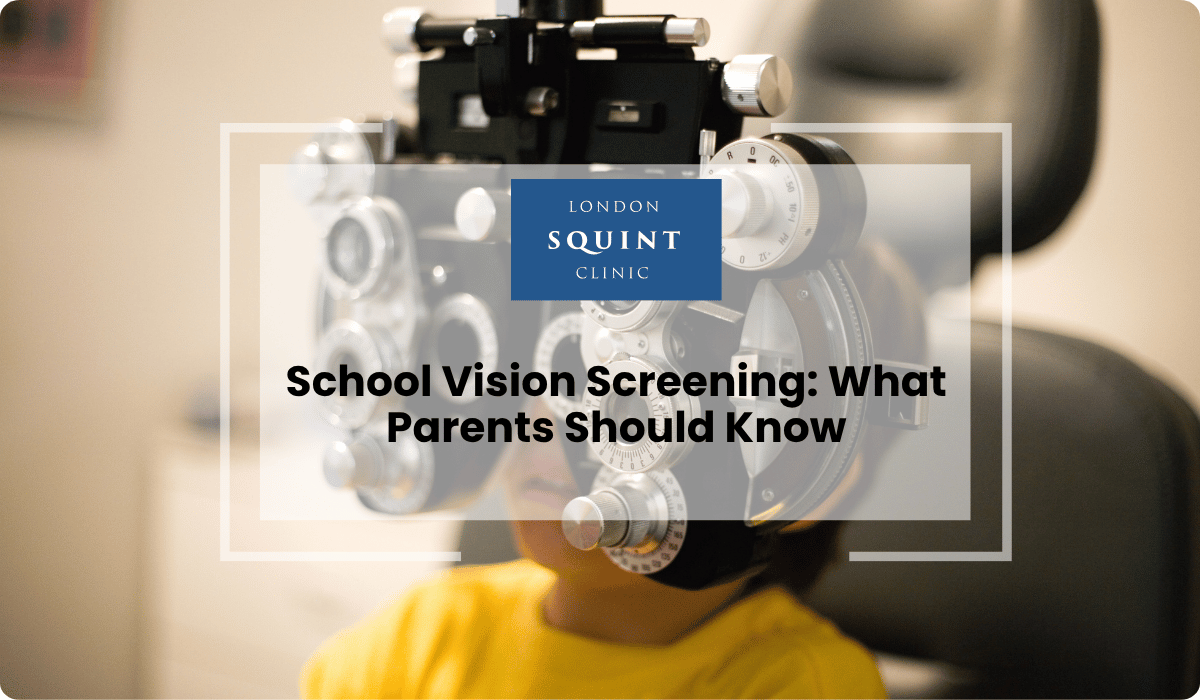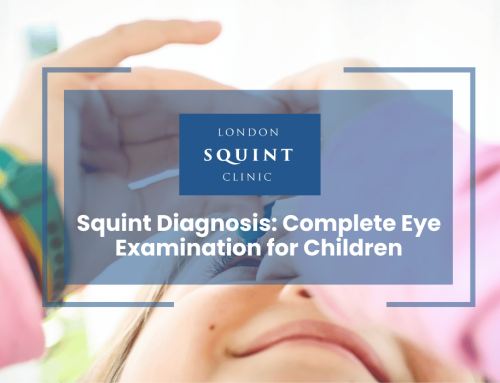School Vision Screening: What Parents Should Know
- School vision screenings are basic assessments that primarily detect distance vision problems but miss many important visual skills needed for learning.
- Most UK children receive vision screening in Reception year (ages 4-5), but follow-up screenings vary by location and are not universally implemented.
- Common vision problems detected include myopia, hyperopia, astigmatism, and sometimes amblyopia or strabismus.
- School screenings have significant limitations—they don’t assess near vision skills, eye coordination, or eye health conditions, and may miss 20-30% of children with vision problems.
- Parents should seek comprehensive eye care if their child shows visual symptoms (headaches, squinting, eye rubbing) even after passing a school screening.
- Creating vision-friendly environments includes proper lighting, appropriate screen use with regular breaks, and modeling healthy visual habits.
Table of Contents
- Understanding School Vision Screening: The Basics
- When and How Often Do Children Receive School Eye Tests?
- What Actually Happens During a School Vision Check?
- Common Vision Problems Detected in School Screenings
- Limitations of School Eye Exams: What They Miss
- Beyond School Screening: When to See a Pediatric Ophthalmologist
- How Parents Can Support Healthy Vision Development
- Creating a Vision-Friendly Environment at Home and School
Understanding School Vision Screening: The Basics
School vision screening programmes serve as an important first-line assessment of children’s visual health within the educational system. These screenings are designed to identify potential vision problems that might interfere with a child’s learning and development. Unlike comprehensive eye examinations performed by ophthalmologists, school vision screenings are brief assessments that typically focus on detecting reduced visual acuity and obvious eye alignment issues.
In the UK, school vision screening is typically conducted by school nurses or trained healthcare professionals who visit schools as part of the national child health programme. The primary purpose is to identify children who may need referral for a more thorough eye examination. These screenings help detect common refractive errors such as myopia (short-sightedness), hyperopia (long-sightedness), and astigmatism, as well as conditions like amblyopia (lazy eye) or strabismus (squint).
It’s important for parents to understand that while school vision screening is valuable, it represents only a basic assessment and not a substitute for comprehensive eye care. These screenings serve as an efficient way to identify children who might otherwise go undiagnosed with vision problems that could impact their educational performance and overall development.
When and How Often Do Children Receive School Eye Tests?
In the UK educational system, the timing and frequency of school vision screenings follow a structured approach aligned with key developmental stages. Most children receive their first school-based vision screening during Reception year (ages 4-5), which coincides with a critical period in visual development and the beginning of formal education. This timing is strategic, as it allows for the early identification of vision problems that might interfere with a child’s ability to learn to read and write.
After this initial screening, the frequency of follow-up vision checks varies across different local authorities. Some areas may offer additional screenings at key transition points, such as when children enter secondary school (around age 11-12). However, it’s worth noting that routine follow-up screenings are not universally implemented across all UK schools, creating potential gaps in ongoing vision monitoring.
The National Screening Committee recommends vision screening for all children aged 4-5 years, but beyond this age, there is less consistency in the provision of school eye tests. This variation means that some children may go several years without formal vision assessment unless parents arrange private eye examinations or unless a teacher or parent notices potential vision difficulties. For children with previously identified vision issues or those at higher risk due to family history of eye conditions, more frequent monitoring outside the school system is typically recommended.
What Actually Happens During a School Vision Check?
School vision checks are designed to be quick, non-invasive procedures that can efficiently screen large numbers of children. During a typical school vision screening, the process focuses primarily on assessing visual acuity—how well a child can see at different distances. The most common component involves reading a standard eye chart (usually a Snellen chart or a LogMAR chart specifically designed for children) from a set distance, typically 6 metres.
For younger children who may not yet recognise letters, modified charts using pictures, shapes, or the letter “E” in different orientations (known as the Tumbling E test) may be used. The screening professional will ask the child to identify what they see, testing each eye separately by covering the other eye with an occluder paddle or patch.
Some more comprehensive school screenings may also include basic assessments of:
- Eye alignment and movement tests to detect obvious squints (strabismus)
- Colour vision testing, particularly for boys who have a higher incidence of colour vision deficiencies
- Stereopsis testing to assess depth perception using special 3D glasses
- Near vision testing to evaluate how well children can focus on close objects
The entire screening typically takes only a few minutes per child. Results are usually recorded as “pass” or “refer,” with parents receiving notification if their child requires further assessment. It’s important to note that these screenings are conducted in school environments that may not be ideal for vision testing, with potential distractions and variable lighting conditions that can affect results.
Common Vision Problems Detected in School Screenings
School vision screenings are primarily designed to identify common visual impairments that may affect a child’s learning ability. The most frequently detected vision problems through these screenings include refractive errors such as myopia (short-sightedness), which has been increasing in prevalence among school-aged children. Children with myopia typically struggle to see distant objects clearly, including the whiteboard or presentations at the front of the classroom.
Hyperopia (long-sightedness) is another common refractive error identified during screenings. While mild hyperopia is normal in young children, significant hyperopia can cause eyestrain, headaches, and difficulty with sustained near vision tasks like reading. Astigmatism, an irregularity in the curvature of the cornea or lens causing distorted vision, may also be flagged during basic visual acuity testing.
Beyond refractive errors, school screenings can sometimes detect signs of amblyopia (lazy eye), particularly when there’s a significant difference in visual acuity between the two eyes. Early detection of amblyopia is crucial as treatment is most effective during childhood. Some screenings may also identify obvious cases of strabismus (squint), where the eyes are misaligned. Children with these conditions often benefit from early intervention with glasses or other treatments to support proper visual development.
It’s worth noting that vision problems can manifest in behavioural signs that teachers might notice, such as frequent eye rubbing, sitting unusually close to the board, tilting the head, or demonstrating reluctance to participate in visual tasks. These observations by educational staff often complement the formal screening process.
Limitations of School Eye Exams: What They Miss
While school vision screenings serve an important purpose, parents should be aware of their significant limitations. These basic assessments primarily focus on distance visual acuity and may miss numerous important aspects of visual function and eye health. One major limitation is that school screenings typically don’t assess near vision comprehensively, which is crucial for reading, writing, and other close-up academic tasks that occupy most of a child’s school day.
School screenings rarely evaluate visual skills essential for learning, including:
- Accommodation (the ability to focus at varying distances)
- Convergence (how well eyes work together for near tasks)
- Tracking (smooth eye movements needed for reading)
- Visual processing (how the brain interprets visual information)
- Eye-hand coordination (crucial for writing and sports)
Additionally, these screenings cannot detect subtle eye alignment issues that may cause eyestrain or headaches with prolonged visual tasks. They also don’t include examination of eye structures or assessment of eye health conditions that might not affect visual acuity but could be serious, such as retinal problems or early signs of glaucoma.
Perhaps most importantly, school vision screenings have a notable false-negative rate, meaning they may miss approximately 20-30% of children with vision problems. Children can sometimes compensate for vision difficulties during brief testing or may have intermittent issues that aren’t apparent during the screening. The pass/fail criteria used in screenings may also miss borderline cases that would benefit from intervention.
Beyond School Screening: When to See a Pediatric Ophthalmologist
While school vision screenings provide a valuable baseline assessment, there are numerous situations that warrant consultation with a paediatric ophthalmologist regardless of screening results. Parents should consider seeking specialist eye care if their child displays any concerning visual behaviours or symptoms, even if they’ve recently passed a school vision check.
Key indicators that suggest the need for comprehensive eye examination include:
- Complaints of frequent headaches, particularly after reading or screen time
- Persistent eye rubbing, squinting, or excessive blinking
- Noticeable eye misalignment or wandering eye, even if intermittent
- Holding books unusually close or sitting very near to screens
- Covering or closing one eye when reading or watching television
- Difficulty with tracking moving objects or following lines of text
- Poor hand-eye coordination beyond what’s developmentally appropriate
- Unexplained decline in academic performance or reading ability
- Family history of significant eye conditions, including childhood eye disorders
Additionally, certain groups of children should receive regular comprehensive eye examinations regardless of school screening results. These include children born prematurely, those with developmental delays, learning disabilities, or neurodevelopmental disorders such as ADHD or autism spectrum disorders. Children with systemic health conditions that can affect vision, such as diabetes or juvenile rheumatoid arthritis, also require specialised eye care beyond what school screenings provide.
Remember that paediatric ophthalmologists have specialised training and equipment to detect subtle vision issues that may be missed in basic screenings but could significantly impact a child’s visual development and learning potential.
How Parents Can Support Healthy Vision Development
Parents play a crucial role in supporting their children’s visual health beyond school screenings. One of the most important steps is observing your child for potential signs of vision problems. Watch for behaviours such as frequent eye rubbing, squinting, head tilting, or complaints about blurry vision. Pay attention to whether your child holds reading materials unusually close or far away, or if they seem to struggle with visual tasks that their peers manage easily.
Establishing good visual habits at home is equally important. Encourage regular breaks during extended near-vision activities like reading or using digital devices—the 20-20-20 rule is helpful: every 20 minutes, look at something 20 feet away for at least 20 seconds. Ensure adequate lighting for reading and homework, and position computer screens at an appropriate distance and angle to reduce eye strain.
Nutrition also plays a significant role in eye health. A balanced diet rich in fruits and vegetables, particularly those containing vitamins A, C, and E, as well as omega-3 fatty acids, supports optimal visual development. Adequate hydration is also important for maintaining healthy eyes.
Perhaps most critically, parents should arrange regular comprehensive eye examinations with qualified eye care professionals, particularly if there’s a family history of eye conditions or if the child shows any signs of visual difficulty. The Royal College of Ophthalmologists recommends that children have their first comprehensive eye examination by age 3-4, and then follow-up examinations as advised by their eye care provider, typically every 1-2 years depending on individual risk factors.
Creating a Vision-Friendly Environment at Home and School
Creating environments that support children’s visual health and development requires thoughtful consideration of both physical spaces and daily routines. At home, start by optimising lighting conditions—natural light is ideal for most activities, but task lighting should be positioned to illuminate work areas without creating glare or shadows. Computer and device screens should be positioned slightly below eye level and at arm’s length to reduce visual strain.
For children who wear glasses, parents should ensure they have properly fitted, comfortable frames that stay in place during activities. Keeping a spare pair at school is advisable, as is teaching children proper care and cleaning of their eyewear. For those engaged in sports, appropriate protective eyewear should be provided to prevent eye injuries.
In the classroom environment, parents can advocate for vision-friendly accommodations when necessary. This might include requesting that a child with visual challenges be seated near the front of the class or where they can best see instructional materials. For children with significant visual needs, parents should consider discussing an Individual Education Plan (IEP) or similar accommodation plan with school administrators.
Digital device use requires special consideration in today’s learning environment. Both parents and teachers should implement the 20-20-20 rule during screen time and ensure that devices have appropriate blue light filters and brightness settings. Text size and contrast should be adjusted for comfortable viewing, and children should be encouraged to maintain proper posture and viewing distance.
Finally, creating a vision-friendly environment includes modelling healthy visual habits. When adults demonstrate proper reading posture, take visual breaks, and prioritise eye protection during activities, children are more likely to adopt these important habits themselves. By combining thoughtful environmental design with consistent visual health practices, parents and educators can significantly support children’s visual development and academic success.
Frequently Asked Questions
At what age do children have their first school vision screening?
In the UK, children typically receive their first school vision screening during Reception year (ages 4-5). This timing coincides with the beginning of formal education and a critical period in visual development, allowing for early identification of vision problems that might interfere with learning to read and write.
What vision problems can school screenings miss?
School screenings primarily focus on distance visual acuity and may miss several important issues including:
– Near vision problems affecting reading
– Visual processing disorders
– Eye tracking and convergence issues
– Subtle eye alignment problems
– Eye health conditions that don’t affect visual acuity
– Intermittent vision problems that aren’t present during testing
How can I tell if my child has vision problems despite passing a school screening?
Look for signs such as frequent headaches after reading, excessive eye rubbing, squinting, holding books unusually close, covering one eye when reading, difficulty following lines of text, declining academic performance, or complaints about blurry vision. These symptoms warrant a comprehensive eye examination even if your child passed their school screening.
How often should children have comprehensive eye examinations beyond school screenings?
The Royal College of Ophthalmologists recommends children have their first comprehensive eye examination by age 3-4, followed by examinations every 1-2 years depending on individual risk factors. Children with existing vision problems, developmental delays, learning disabilities, or family history of eye conditions may need more frequent assessments.
What should I do if my child fails a school vision screening?
If your child fails a school vision screening, you should arrange a comprehensive eye examination with an optometrist or ophthalmologist as soon as possible. Bring the screening results to this appointment. Early intervention for vision problems is crucial for preventing potential impacts on learning and development.
How can I reduce eye strain from digital devices for my school-aged child?
Implement the 20-20-20 rule (every 20 minutes, look at something 20 feet away for 20 seconds), ensure proper screen positioning at arm’s length and slightly below eye level, adjust text size and contrast for comfortable viewing, use blue light filters, ensure adequate room lighting to reduce screen glare, and limit recreational screen time outside of school requirements.
Can vision problems be mistaken for learning disabilities?
Yes, undetected vision problems can sometimes be mistaken for learning disabilities. Issues with tracking, convergence, visual processing, or uncorrected refractive errors can cause symptoms similar to dyslexia, ADHD, or other learning difficulties. Children struggling academically should have comprehensive vision assessments before or alongside educational evaluations to rule out vision-related causes.
Find out if you are suitable for Double Vision Treatment
Not everyone is eligible for double vision surgery.
Find out if you could benefit from this life-changing surgery by taking the quick self-suitability quiz below:
Our most popular procedures

Hello, I’m Nadeem Ali
I’m one of the few eye surgeons in the world with 100% focus on Squint and Double Vision Surgery.
I have 24 years of eye surgery experience, and worked for 13 years as a Consultant at London’s renowned Moorfields Eye Hospital.
In 2023, I left the NHS to focus fully on treating patients from across the world at the London Squint Clinic. You can read more about me here.
There’s lots of information on the website about: squint surgery, double vision surgery and our pricing.
The most rewarding part of my job is hearing patients tell me how squint or double vision surgery has changed their lives. You can hear these stories here.
Mr Nadeem Ali
MA MB BChir MRCOphth FRCSEd(Ophth)





